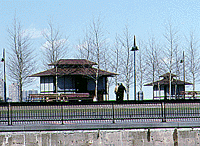
(June 2001)
Ten years ago, Pier A at Hoboken’s south waterfront was slated for a 1.1 million square foot, 33-story office complex to be built over the Hudson River. Today it is a five-acre award-winning public park that people flock to on a warm summer day. The June 2001 issue of Landscape Architecture features a cover story on this park, entitled “Roots over the River.”
The article describes the genesis of this park for Hoboken which a short time ago had the lowest open-space-to-population ratio anywhere in the state of New Jersey. When the Port Authority of New York and New Jersey and the City of Hoboken proposed their massive 3.2 million square foot project for Hoboken’s waterfront, the local citizenry became outraged. The article states, “Not only would the towers make Hoboken look egregiously like Jersey City, the city just south of Hoboken, but they would also effectively block public access to the waterfront.”
In 1990, a local civic organization, the Coalition for a Better Waterfront, defeated this high-rise project in a public referendum election. After their victory, the Coalition then formed a group of local architects, planners and other professionals to develop a plan for the Hoboken waterfront that preserved the water’s edge as a public waterfront park. Several years later, the City of Hoboken adopted most of the principles embodied in the Coalition’s plan for the south waterfront, including the waterfront park concept.
One of the professionals, landscape architect Cassandra Wilday, who worked on the Coalition’s waterfront plan, was hired by the City of Hoboken, along with landscape architect Henry Arnold to design the park at Hoboken’s south waterfront. Arnold is the author of Trees in Urban Design (Van Nostrand Reinhold, 1994). In the Landscape Architecture article, Wilday states, “We tried to create a park that’s simple and durable. There aren’t a lot of bells and whistles.” Now three years old, Pier A Park is notable for the large grove of well-established London Plane trees and a rugged lawn that thrives despite its intensive use from Spring through Fall. One of the innovations brought by these landscape architects to this park is air-entrained soil. This lightweight mix containing porous aggregates prevents soil compaction despite constant foot traffic. Thus, the trees and lawn on Pier A Park are flourishing.
Last year, the American Society of Landscape Arhitects bestowed upon Pier A Park an honor award for design. That same year, the Waterfront Center based in Washington, D.C. designated Pier A Park the winner of the Excellence on the Waterfront honor award. The park got a third award from the New Jersey Society of Landscape Architects.
The concept of a continuous, linear waterfront park put forth by the Coalition for a Better Waterfront in 1990 is now becoming a reality. The portion of the waterfront park from 2nd to 4th Streets is now under construction. This will connect Pier A Park to Sinatra Park. Castle Point Park is also under construction. The waterfront promenade at the Shipyard Project was finally opened to the public last month. The Coalition for a Better Waterfront and its sister organization, the Fund for a Better Waterfront, are now working on the important links that will ensure that the park be continuous from one end of Hoboken to the other. These organizations are currently working closely with the developers of the Maxwell House site at Hoboken’s north waterfront to create a waterfront park at this location.
FBW Editorial
